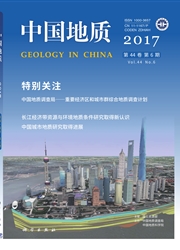

 中文摘要:
中文摘要:
岗上超镁铁质岩主要由纯橄岩和石榴橄榄岩组成,主要组成矿物橄榄石、铬铁矿、石榴子石、单斜辉石和斜方辉石等。铬铁矿的Cr#[Cr/(Cr+Mg)×100]从51到89变化.铬铁矿矿物表现为4期次演化的特点,反映了从岩浆期向榴辉岩相、角闪岩相和绿片岩相演化特征。随着超镁铁质岩的演化,铬铁矿中Cr#不断增大,而铬铁矿Mg#[Mg×l00/(Mg+Fe^2+)]不断减少.氧逸度不断增加。在绿片岩相一绿片角闪岩相退变质过程中,铬铁矿中Cr,Mg和Al减少,Fe相对增加,产生富Cr尖晶石变质作用样式。晚期剪切变形等次生变化有利于富铬铬铁矿矿物的形成和铬铁矿的富集。同时,绿片岩相变质作用降低了铬铁矿与其他硅酸盐矿物的结合强度.降低了开采强度和成本,使原本不易于开采的铬铁矿体变得可以开采。这些意味着该地区铬铁矿矿体展布要结合区域构造特征和变质作用进行研究、尤其是结合中晚期脆韧性构造进行分析。
 英文摘要:
英文摘要:
Gangshang ultramafic rocks are mainly composed of garnet peridotites and dunite, which contain o/ivine, chromium spine/, diopside, endiopside, or/and garnet, orthopyroxene, amphibole and phlogopite. Chromium spinels in Gangshang ulttamatic rocks are composidonaily variable, with Cr# (molar100Cr/(Cr+Al)) varying from 51 to 89, and are associated with four stages of ultramafic rocks. With the increase of Cr# in chrome spinels Mg# (molarl00Mg/(Mg +Fe^2+))of chromium spinets decreases,whereas oxygen fugacity increases, as reflected by the composition of Gangshang chromium spinels. In the process of retrometamorphism of amphibole-facies and greemchist-facies, Cr, Mg and A1 of chromium spinels decrease, whereas Fe rehtively increase. In addition, Gangsbang ultramafic rocks experienced shearing reformation and CO metasomatism, which was helpful to the enrichment of chromium and the formation of chromium spinel. This mechanism is also useful to understanding the development of chromite deposits in some metamorphic areas and the enrichment of some chromite ore bodies.
 同期刊论文项目
同期刊论文项目
 同项目期刊论文
同项目期刊论文
 期刊信息
期刊信息
